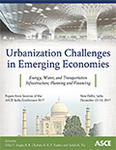ASCE India Conference 2017
Numerical Simulation and Profile Computation of Hydraulic Jump under the Sluice Gate
Publication: Urbanization Challenges in Emerging Economies: Energy and Water Infrastructure; Transportation Infrastructure; and Planning and Financing
ABSTRACT
Hydraulic jump formation takes place during the transition of super-critical flow to sub-critical flow. The objective of this paper is to trace the water surface profile of hydraulic jump formed under the sluice gate. It is done by assuming water surface as implicit function (depend on both x and y) profile and taking four readings of water surface elevation at various intervals. These readings are used to solve the equations to get unknown variables that result in the formation of an equation. The resultant equation is used to get a differential equation in both x and y. The differential equation is solved by using numerical corrector and predictor method. The depth of water surface profile is predicted and this value is further used to get the correct value. This value is adjusted until both predicted and corrected values give the same result. The values obtained depend on the trends followed by previous readings. The current obtained value is further used to get the next value. This procedure is repeated till we achieve the water surface profile up to the desired distance from sluice gate. The obtained data is represented on the graph and the variation in elevation is analyzed at different Froude numbers range. The computation of profile gives fruitful results at the lower range of Froude numbers, as the energy loss is very high at higher range of Froude number, and turbulence factor would also considered. The obtained readings compared with experimental readings, and the readings are acceptable within certain error limits.
Get full access to this chapter
View all available purchase options and get full access to this chapter.
REFERENCES
Abbott, M. B., Marshall, G., and Rodenhuis, G.S. (1969). “Amplitude-Dissipative and Phase-Dissipative Scheme for Hydraulic Jump Simulation,” Proc, 13th Congress Inter. Assoc. Hyd. Research, Tokyo, pp. 313-329.
Anderson, D. A, Tannehill, J. D, and Pletcher, R. H. (1984). “Computational fluid mechanics and heat transfer.” McGraw-HillBook, N.Y.ASCE Task Force, New York.
Bradely, J. N, and Peterka, A.J. (1957). “Hydraulic design of stilling basins.” Hydr. Div. ASCE, 83(5), 1401-1406.
Carvalho, R. F., Lemos, C. M., and Ramos, C.M. (2008). “Numerical computation of the flow in hydraulic jump stilling basins.” Journal of Hydraulic Research. 46(6), 739-752.
F. Ayça Varol, Esin Çevik, and Yalçın Yuksel (2009). “The Effect of Water Jet on the Hydraulic Jump.” International Water Technology Conference, IWTC 13 2009, Hurghada, Egypt.
Francesco Giuseppe Carollo, Vito Ferro, and Vincenzo Pampalone (2007). “New Solution of Classical Hydraulic Jump.” Journal of Hydraulic Engineering© Asce.
Garci'a-Navarro, P., Alcrudo, F., and Saviron, J. M. (1992).1-D “Open-Channel Flow Simulation Using TVD Mccormack Scheme.” Journal of Hydraulic Engineering., 118, 1359-1372.
Gharangik, A. M (1988). “Numerical Simulation of Hydraulic Jump,” thesis presented at Washington State University, at Pullman.
Hafnaoui, M. A, Carvakho, R. F and Debabeche, M. (2016) “Prediction of Hydraulic Jump location in Some Types of Prismatic channels Using Numerical Modelling.” International Junior Researcher and Engineer Workshop on Hydraulic Structures, University of Biskra, Algeria.
Iwao Ohtsu, and Youichi Yasuda (1991). “ Hydraulic Jumps in Sloping Channels.”Journal of Hydraulic Engineering © Asce.
K Subramanya (2008), “Flow in open channel.” McGraw Hill, New York.
Youngkyu Kim, Gyewoon Choi, Hyoseon Park, and Seongjoon Byeon (2015). “Hydraulic Jump and Energy Dissipation with Sluice Gate.”. Basel, Switzerland.
Information & Authors
Information
Published In
Urbanization Challenges in Emerging Economies: Energy and Water Infrastructure; Transportation Infrastructure; and Planning and Financing
Pages: 210 - 220
Editors: Udai P. Singh, B. R. Chahar, Indian Institute of Technology, H. R. P. Yadav, Institution of Engineers (India), and Satish K. Vij
ISBN (Online): 978-0-7844-8202-5
Copyright
© 2018 American Society of Civil Engineers.
History
Published online: Dec 13, 2018
Authors
Metrics & Citations
Metrics
Citations
Download citation
If you have the appropriate software installed, you can download article citation data to the citation manager of your choice. Simply select your manager software from the list below and click Download.
